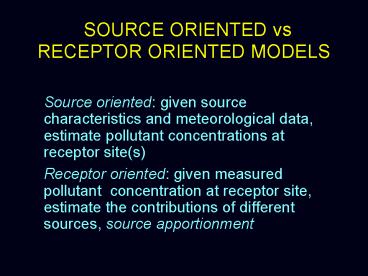SOURCE ORIENTED vs RECEPTOR ORIENTED MODELS - PowerPoint PPT Presentation
1 / 31
Title:
SOURCE ORIENTED vs RECEPTOR ORIENTED MODELS
Description:
The factors are then interpreted as types of sources. Positive Matrix Factorization, PMF ... are the source profiles, or fingerprints, of a list of compounds ... – PowerPoint PPT presentation
Number of Views:153
Avg rating:3.0/5.0
Title: SOURCE ORIENTED vs RECEPTOR ORIENTED MODELS
1
SOURCE ORIENTED vs RECEPTOR ORIENTED MODELS
- Source oriented given source characteristics and
meteorological data, estimate pollutant
concentrations at receptor site(s) - Receptor oriented given measured pollutant
concentration at receptor site, estimate the
contributions of different sources, source
apportionment
2
Receptor models
- CMB Chemical Mass Balance
- Factor Analysis (Multivariate methods)
- PCA Principal Component Analysis
- PMF Positive Matrix Factorization
3
Chemical Mass Balance Receptor Modelling
Source 1xi1 i1,n
3
Receptoryi i1,n
1
Source 3xi3 i1,n
2
Source 2xi2 i1,n
4
Chemical Mass Balance Receptor Modelling
5
Chemical Mass Balance Receptor Modelling
6
Chemical Mass Balance Receptor Modelling Simple
Spreadsheet Implementation
- Electronic spreadsheets like Excel make it easy
to implement the model in the above form. - The Solver function in Excel enables the
minimization operation. - Graphical tools in Excel enable qualitative
assessment of model fit and the inputs.
7
(No Transcript)
8
(No Transcript)
9
(No Transcript)
10
(No Transcript)
11
Chemical Mass Balance Receptor Modelling U.S.
EPAs CMB Model
- There are uncertainties associated with both the
receptor and source profiles. The measured
quantities are thus - The model results then also have uncertainties
associated with them
12
U.S. EPAs CMB Model The effective variance
method
- The CMB model uses an effective variance which
looks at variances in both the receptor, and
source profiles weighted by the source
contributions
13
U.S. EPAs CMB8
- The CMB model incorporates the statistics to
improve our estimate of the source contributions
by weighting the source and receptor profiles
according to the uncertainties associated with
them. - It also reports the uncertainties associated with
the source contribution estimates and goodness
of fit parameters. - Version 8 is windows based, more user friendly.
- Example Source apportionment for motor vehicle
related VOCs in micro-environments
14
VOC's Associated with Motor Vehicles
Exhaust EmissionsEvaporative Emissions
C1 - C10 RangeAlkanesAlkenesAlkynesCycloalkane
sAromatics
15
Chemical Mass Balance Receptor Modelling
Source profile characterization
Fuel
Whole gasoline
Headspace vapor
Individual vehicles
Exhaust emissions - UDDS
Evaporative emissions - SHED
Fleet emission characteristics
Tunnel studies Roadside measurements
16
Source Profiles
17
ERMD Source Profiles with 17 species
0.45
0.4
0.35
0.3
0.25
Fraction of total
0.2
0.15
0.1
6 GA
0.05
5 LPG
4 CNG
0
3 HOTST
2 COLDST
1 FUEL
Ethylene
Ethane
Propane
n-butane
n-pentane
benzene
3m-pentane
e-benzene
o-xylene
18
1994 Fleet Average Emissions with two fuels
19
Modelled Species Profile
3m-pentane m-cyclopentanebenzene
cyclohexane iso-octanen-heptane toluene
n-octane e-benzenemp-xylenen-nonane1,2,4-t
m-benzene
ethylene acetylene ethane propane
isobutane isobutylenen-butane 2m-butane
n-pentane 2,3-dm-butane 2m-pentane
Fitting species
20
Nose-level Ambient Sampling Schedules
Slater Street Curbside 20 Weekdays in
August-September
2 Stations, 3 Sampling Sessions Morning
730-930Noon 1130-1330Afternoon
1530-1730 (Evening 2200 - 2400)
- 3 Underground Garages
- 12 Weekdays in December-January
- 2 Stations, 2 Sampling sessions in each garage
- A.M. 730 - 930
- P.M. 1500 - 1700
21
(No Transcript)
22
(No Transcript)
23
(No Transcript)
24
- Watson, J.D., E. Fujita, J.C. Chow, and B.
Zielinska. 1998. Northern Front Range Air Quality
Study Final Report., Desert Research Institute.
25
Other receptor models
- CMB applies the mass balance principles to known
receptor and source compositions to arrive at the
source contribution estimates. - Another type of source apportionment analyzes
multiple measurements at the receptor (I.e. many
hours of hourly average data) without prior
knowledge of the sources but attempts to identify
factors that explain the variation in the
composition. The factors are then interpreted as
types of sources.
26
Positive Matrix Factorization, PMF
27
Positive Matrix Factorization, PMF
28
CMB vs PMF, pros and cons
- In CMB the required data are the source profiles,
or fingerprints, of a list of compounds for all
potential sources and the corresponding ambient
measurements. CMB modelling can be done
individually for each ambient measurement (even a
single one!) but getting the source profiles for
locally relevant sources requires much effort.
29
CMB vs PMF, pros and cons
- In PMF, many ambient measurements are obtained
over a long time period. Statistical analysis of
the trends in the individual measured components
then leads to the identification of factors"
that explain the variation. These factors can
then be identified with potential sources.
Actual source profile measurements are not
required. Instead, collecting sufficiently long
time series data on ambient concentrations
becomes the critical issue.
30
CMB PMF Comparison
- Even a single receptor observation can be
analyzed by CMB, assuming we have characterized
the potential sources. - PMF does not require that we characterize the
potential sources but it does require sufficient
observations to identify the potential sources.
31
The SPECIATE database
- Source profiles for PM and VOC samples are
compiled in a database (SPECIATE) which reports
measurements from different studies. - The profiles in this database can be extracted
for use with CMB.































